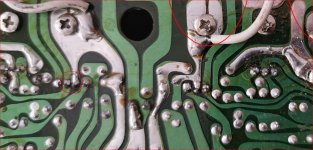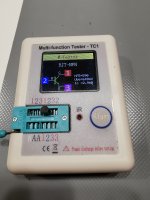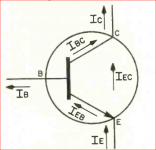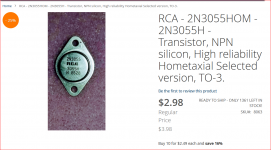I doubt Q405 or Q406 were ever a problem and I am still waiting for a reply on Q401 and Q402 both BC550C's - are these working properly.
I just pulled both 401 and 402 from the circuit and tested them. They seem to be fine (attached pics)
It appears that one of the driver transistors has a solder bridge between two of the leads. If so you need a solder sucker to remove it.
That was just rosin... I did check for shorts and now that you've mentioned it I cleaned the excess rechecked for shorts. All seems fine.
Attachments
"risky" refers to untested operating conditions. In this case the risk is instability as temperature rises at higher power levels. It's called thermal runaway because it starts slowly and speeds up with rising temperature toward the destruction of the output stage semis as bias current continues to rise uncontrolled.
So why would one not consider this as a possible cause of heating in Q407and Q408 - albeit that this is limited through the bias applied to the respective bases by Q405 and Q406.
Last edited:
@zenzaman
I know from experience that carbon film resistors can burn out without showing any visible signs and have witnessed that these do smoke and smell when they blow. Lower resistance value ones would conduct more current and be more at risk if there is a surge in current like those you have witnessed yourself.
I know from experience that carbon film resistors can burn out without showing any visible signs and have witnessed that these do smoke and smell when they blow. Lower resistance value ones would conduct more current and be more at risk if there is a surge in current like those you have witnessed yourself.
Last edited:
@zenzaman
I found a repair job on youtube for a NAD3020 which gives some tips on how to go about fixing a distorting channel. The tech running the video printed off a copy of the schematic and noted some voltage measurement as strategic points on the paper. These may be a useful guide which might short-cut back lengthy discussions and give you the benefit of professional advice.
NAD 3020 Helpdesk: Trouble-shooting a Distorted Channel on your 3020 - YouTube
I found a repair job on youtube for a NAD3020 which gives some tips on how to go about fixing a distorting channel. The tech running the video printed off a copy of the schematic and noted some voltage measurement as strategic points on the paper. These may be a useful guide which might short-cut back lengthy discussions and give you the benefit of professional advice.
NAD 3020 Helpdesk: Trouble-shooting a Distorted Channel on your 3020 - YouTube
thank you!
I started last night to take comparative measurements between channels but it was already late and decided to leave it for when I have a clear head. I'll follow the advice from the video and also take notes as I move along.
I started last night to take comparative measurements between channels but it was already late and decided to leave it for when I have a clear head. I'll follow the advice from the video and also take notes as I move along.
Here is a further youtube reference with NAD3225PE closer relation to your NAD7020I.
#86 - NAD 3225PE stereo amplifier repaired and tested - YouTube
#86 - NAD 3225PE stereo amplifier repaired and tested - YouTube
I may not be following your query but runaway is a terminal event. It begins in an apparently stable state but with rising temperature and falling resistance of the semis, bias current increases exponentially. Usually, it all happens so fast that by the time it's detected, it's beyond the ability of the bias control circuit and well beyond our ability to intervene with the power switch.So why would one not consider this as a possible cause of heating in Q407and Q408.....
I consider semis that are simply hotter than normal to still be in a stable state but I guess there's no reason excess or unstable bias couldn't both be down to the same cause.
Yes to both cases.
I have a text book that gives a detailed explanation of thermal effects on semiconductors. The book is not easy to photocopy so I will have to type this out.
In the meantime I am attaching the image of a transistor showing the directional flow of external and internal current which is opposite to the direction of the emitter arrow.
One point not mentioned in the text is that the collector region within a transistor is more heavily doped than the emitter or the base regions so heating on the collector will release more electrons in a NPN transistor and make the region more conductive.
In a homotaxial transistor I think the collector doping would be reduced near at the extremity point to make this less conductive and the device less susceptible to secondary breakdown.
I have a text book that gives a detailed explanation of thermal effects on semiconductors. The book is not easy to photocopy so I will have to type this out.
In the meantime I am attaching the image of a transistor showing the directional flow of external and internal current which is opposite to the direction of the emitter arrow.
One point not mentioned in the text is that the collector region within a transistor is more heavily doped than the emitter or the base regions so heating on the collector will release more electrons in a NPN transistor and make the region more conductive.
In a homotaxial transistor I think the collector doping would be reduced near at the extremity point to make this less conductive and the device less susceptible to secondary breakdown.
Attachments
Effects of Temperature
The reference book I mentioned is Semiconductors from A to Z by Phillip Dahlen based on a series of articles in Electronic Technician magazine first published in book form by Foulsham-Tab in 1968 and revised in 1973 - the edition I have.
Electronic Technician magazine is one of a number of Electronics magazines in World Radio archives.
The home page is shown in the image. When you click on Electronics Technician you have to scroll down to 1966 and view the September issue which is the second chapter article in the series entitled "Semiconductor Characteristics".
The third chapter is entitled "Determining Semiconductor Characteristics discussing Emitter Current Gain and Base Current Gain - understanding these and using them for trouble-shooting.
The fourth chapter is entitled "Frequency Limitations".
The narrative is down to earth and I like the clarity in this. Others reading these sections might find this as interesting as I have.
The reference book I mentioned is Semiconductors from A to Z by Phillip Dahlen based on a series of articles in Electronic Technician magazine first published in book form by Foulsham-Tab in 1968 and revised in 1973 - the edition I have.
Electronic Technician magazine is one of a number of Electronics magazines in World Radio archives.
The home page is shown in the image. When you click on Electronics Technician you have to scroll down to 1966 and view the September issue which is the second chapter article in the series entitled "Semiconductor Characteristics".
The third chapter is entitled "Determining Semiconductor Characteristics discussing Emitter Current Gain and Base Current Gain - understanding these and using them for trouble-shooting.
The fourth chapter is entitled "Frequency Limitations".
The narrative is down to earth and I like the clarity in this. Others reading these sections might find this as interesting as I have.
Attachments
Yes there's also literally tons of other high quality scanned and valuable, archived publications on that site. It even has the most complete collection of Wireless World Magazine you're ever likely to see, and virtually free to read!
As that thread indicates, RCA quit making homotaxial transistors in the late 70's. others a few years later. The RCA NJ factory is now a county park. I think Comitern in Eastern Europe made the last of them. You are not going to find any. Of course, you can buy any number you want on aliexpress or ebay. See "my transistors are they fake" at the head of parts forum.
Re hometaxial 2N3055's, Western Electric a US surplus stocks clearing house in Ohio is offering over a thousand of them for sale. Full contact details are given on their web page.
Attachments
- Home
- Amplifiers
- Solid State
- NAD 7020i sudden death





